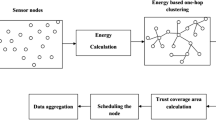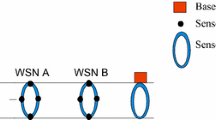Abstract
Being deployed in narrow but long area, strip wireless sensor networks (SWSNs) have drawn much attention in applications such as coal mines, pipeline and structure monitoring. One of typical characteristics of SWSNs is the large hop counts, which leads to long end-to-end delivery delay in low-duty-cycle SWSNs. To reduce the delay, pipeline scheduling is a promising technique, which assigns sensor nodes sequential active time slots along the data forwarding path. However, pipeline scheduling is prone to failure when communication links are unreliable. In this paper, we propose an opportunistic pipeline scheduling algorithm (OPS) for SWSNs, based on the observation that sensor nodes in SWSNs can overhear data transmissions passing by them. OPS exploits nodes outside the data forwarding path to opportunistically provide links when transmission failure happens, and hence maintains the pipeline forwarding instead of retransmission in the next duty cycle. Theoretical calculation shows that the expectation delay of OPS is always smaller than that of existing methods when the link quality is <100 %. Both extensive simulations and experiments are conducted. The results verify that the average end-to-end delivery delay of OPS is usually <60 % of that of existing methods, while the energy cost is almost the same.













Similar content being viewed by others
References
Chen, C. W., & Wang, Y. (2008). Chain-type wireless sensor network for monitoring long range infrastructures: Architecture and protocols. International Journal of Distributed Sensor Networks, 4(4), 287–314.
Guo, P., Jiang, T., & Zhang, K. (2012). Novel energy-efficient miner monitoring system with duty-cycled wireless sensor networks. International Journal of Distributed Sensor Networks.
Jawhar, I., Mohamed, N., & Agrawal, D. P. (2011). Linear wireless sensor networks: Classification and applications. Journal of Network and Computer Applications, 34(5), 1671–1682.
Stoianov, I., Nachman, L., & Madden, S. (2007). PIPENET: A wireless sensor network for pipeline monitoring. In The international conference on information processing in sensor networks (IPSN), Cambridge, MA, USA.
Vasanthi, N. A., & Annadurai, S. (2006). AWS: Asynchronous wakeup schedule to minimize latency in wireless sensor networks. In Proceedings of SUTC (pp. 144–151), Taichung, Taiwan.
Sun, Y., Du, S., Gurewitz, O., & Johnson, D. B. (2008). DW-MAC: A low latency, energy efficient demand-wakeup MAC protocol for wireless sensor networks. In Proceedings of MobiHoc (pp. 53–62), Hong Kong, China.
Guo, S., Gu, Y., Jiang, B., & He, T. (2009). Opportunistic flooding in low-duty-cycle wireless sensor networks with unreliable links. In Proceedings of MobiCom (pp. 133–144), Beijing, China.
Lu, G., Krishnamachari, B., & Raghavendra, C. (2004). An adaptive energy-efficient and low-latency MAC for data gathering in wireless sensor networks. In Proceedings of IPDPS (pp. 224–230), Santa Fe, New Mexico.
Cao, Q., Abdelzaher, T. F., He, T., & Stankovic, J. A. (2005). Towards optimal sleep scheduling in sensor networks for rare event detection. In Proceedings of IPSN, UCLA (pp. 20–27), Los Angeles, CA, USA.
Keshavarzian, A., Lee, H., & Venkatraman, L. (2006). Wakeup scheduling in wireless sensor networks. In Proceedings of MobiHoc (pp. 322–333), Florence, Italy.
Cao, Y., Guo, S., & He, T. (2012). Robust multi-pipeline scheduling in low-duty-cycle wireless sensor networks. In Proceeding of INFOCOM, Orlando, USA.
Ye, W., Heidemann, J., & Estrin, D. (2002). An energy-efficient MAC protocol for wireless sensor networks. In Proceedings of INFOCOM (pp. 567–576), New York, USA.
Park, T. R., & Lee, M. (2008). Power saving algorithms for wireless sensor networks on IEEE 802.15.4. IEEE Communication Magazine, 46(6), 148–155.
Vasanthi, N. A., & Annadurai, S. (2006). Energy efficient sleep schedule for achieving minimum latency in query based sensor networks. In Proceedings of SUTC (pp. 214–219), Taichung, Taiwan.
Cao, Q., Abdelzaher, T., He, T., & Kravets, R. (2007). Cluster-based forwarding for reliable end-to-end delivery in wireless sensor networks. In Proceedings of INFOCOM (pp. 1928–1936), Anchorage, AK, USA.
Sanjit Biswas, R. M. (2005). ExOR: Opportunistic multi-hop routing for wireless networks. In Proceedings of SIGCOMM (pp. 133–144), Philadelphia, PA, USA.
Mohamed, N., Al-Jaroodi, J., Jawhar, I., & Lazarova-Molnar, S. (2013). Failure impact on coverage in linear wireless sensor networks. In 2013 International symposium on performance evaluation of computer and telecommunication systems (SPECTS), Toronto, Canada.
Fonseca, R., Gnawali, O., Jamieson, K., & Levis, P. (2007). Four bit wireless link estimation. In Proceedings of HotNets, Atlanta, GA, USA.
Becher, A., Landisiedel, O., & Wehrle, K. (2008). Towards short-term wireless link quality estimation. In Proceedings of EmNets, Chalottesville, USA.
Maroti, G. S. M., Kusy, B., & Ledeczi, A. (2004). The flooding time synchronization protocol. In Proceedings of SenSys (pp. 39–49), Baltimore, MD, USA.
Jurdak, R., Baldi, P., & Lopes, C. V. (2007). Adaptive low power listening for wireless sensor networks. IEEE Transactions on Mobile Computing, 6(8), 1–17.
Zuniga, M., & Krishnamachari, B. (2004). Analyzing the transitional region in low power wireless links. In Proceedings of SECON (pp. 517–526), Santa Clara, USA.
Acknowledgments
The work presented in this paper was supported in part by the NSF of China with Grants 61272053 and 61271226.
Author information
Authors and Affiliations
Corresponding author
Rights and permissions
About this article
Cite this article
Guo, P., Meratnia, N., Havinga, P.J.M. et al. OPS: Opportunistic pipeline scheduling in long-strip wireless sensor networks with unreliable links. Wireless Netw 21, 1669–1682 (2015). https://doi.org/10.1007/s11276-014-0807-x
Published:
Issue Date:
DOI: https://doi.org/10.1007/s11276-014-0807-x




